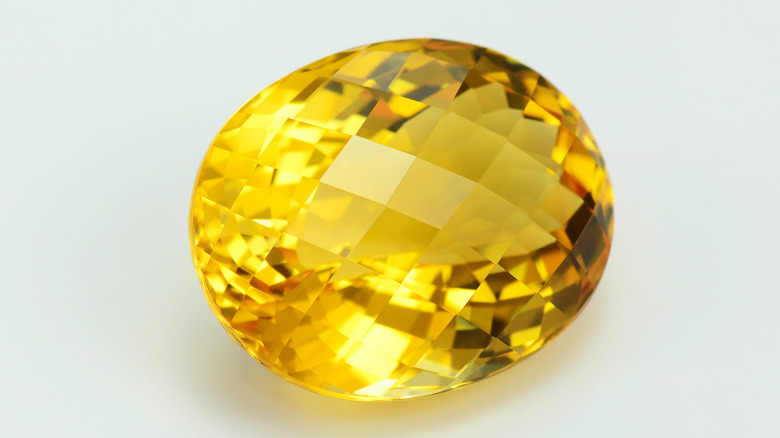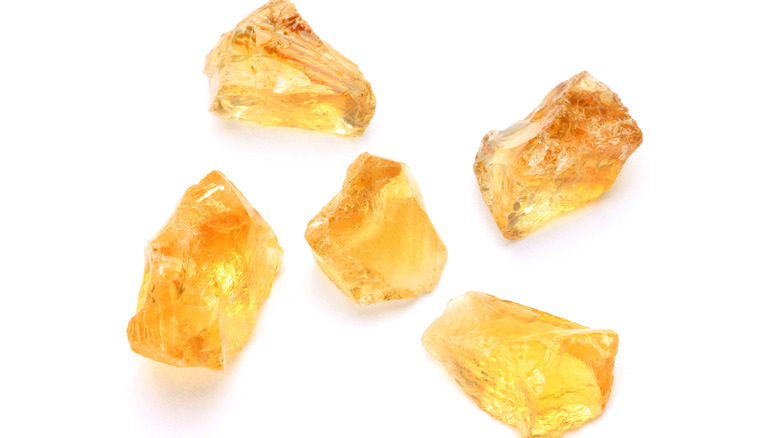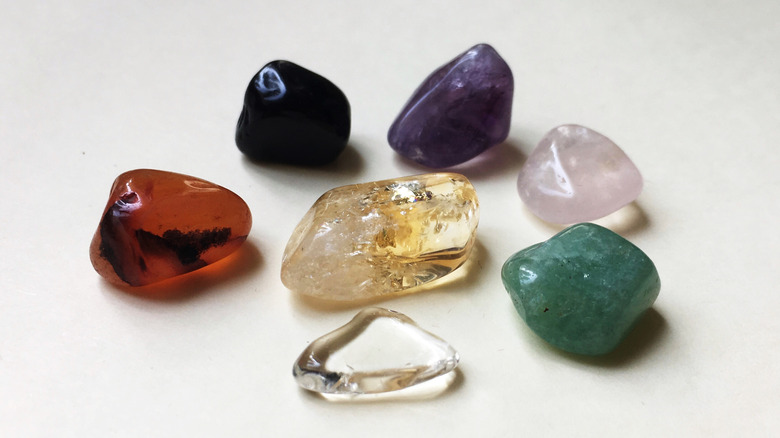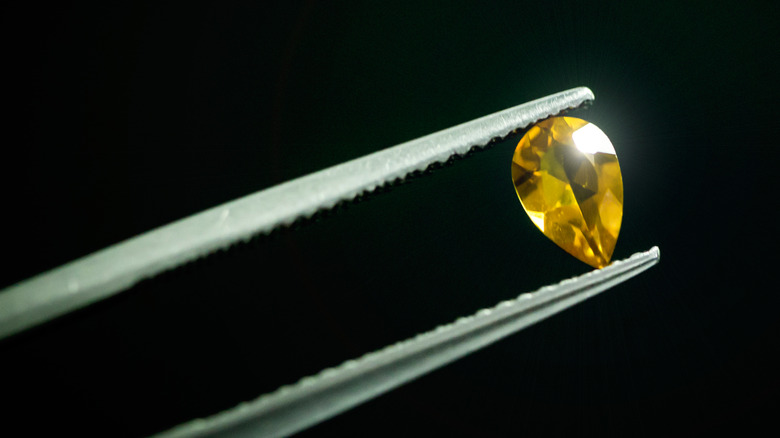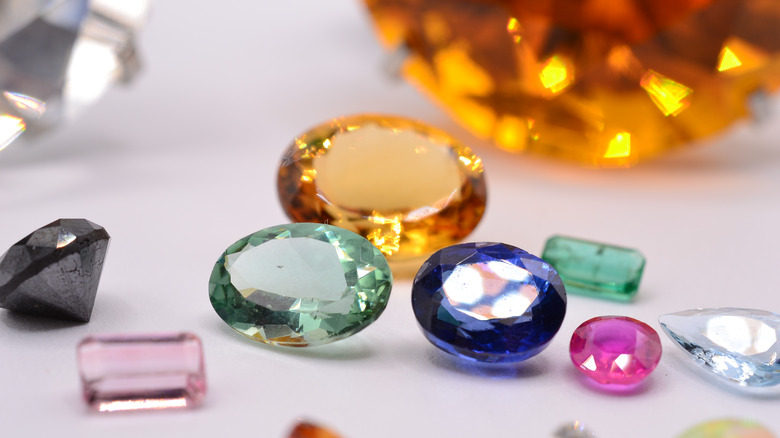What Is Citrine And How Can It Be Good For Your Home?
Need an energy boost? With vigor like the sun, citrine is a multi-purpose, multifaceted quartz crystal known for promoting wealth, prosperity, and positivity in everyday life. From its uplifting physical and spiritual attributes to its emotional and medicinal healing, the power of citrine is limitless. Known as "The Merchant's Stone," it can attract goodness by absorbing negativity and transmuting it into positivity, per Crystal Vaults. With all of citrine's good vibrations, it doesn't need to be cleaned or cleared like most crystals. Citrine is a brilliant yet rare type of quartz crystal often associated with the practice of feng shui. Dating back to approximately 300 B.C., the golden crystal was commonly used as an ornamental gemstone in Greece and Rome. Ancient people believed in the stone's energy to drive out vile thoughts, along with the gift of prosperity for whoever obtained it. The inspiring crystal became popular again in the world of fashion and jewelry amidst the Art Deco period of the Roaring 20s.
Citrine appears transparent, with sparkled inclusions often present, as it radiates a sense of balance, happiness, and strength. Traces of iron give citrine its lovely pale yellow to gold color; darker shades, which appear like raw honey, prove its value (darker pieces are pricier). Because raw citrine is so scarce, amethyst is often disguised as the yellow crystal by the process of being heat-treated. The golden amethyst is then sold on the market to resemble original citrine.
The meaning behind citrine
Citrine originates from the French word citron, which means lemon. The lemony rock can be found around the world, but its main sources have been established in Brazil, France, Madagascar, Russia, the UK, and parts of the US. From its ancient history to its multi-functional abilities, citrine has a big reputation. Highly sought after, its earthy, golden hues are often associated with the energy of the sun and the warmth of summer, as it is linked to the elements of fire and earth. With its vigorous colors and clarity, citrine emanates a positive promotion to your overall mental, emotional, and physical well-being.
Through the healing act of meditation, citrine is prominently used in the sacral chakra area of the body. The verve of the stone flows to the sacral zone when held, then on to the solar plexus, where it awakens one's creative mind, including personal manifestation. In addition, if you were born under these astrological signs, you may receive the ultimate benefit from citrine: Aries, Gemini, Leo, and Libra.
Why should you use citrine?
There are several ways to use citrine in your life and home, such as your office, bedroom, or living area. Its radiance offers the ultimate uplift wherever you place it. You might try putting your crystal in different locations until one feels just right. The positive vibes may encourage generosity and positive communication in your relationships with others, vital for entertaining. For artists, creativity and imagination are an ideal benefit. Citrine is a natural tool in rejuvenating your home life and sanctity in the way it converts unwanted thoughts and emotions into newfound feelings of positivity. You might try placing a piece of it over your heart (or wear a pendant), then hold it and breathe in with the intention of negativity being absorbed and converted. From necklaces to bracelets and rings, jewelry is an effective way to utilize the benefits of citrine's transforming light, whether you're wearing it at home or elsewhere.
When purchasing citrine, you might consider which type to choose as an investment for the future. A piece of citrine jewelry, a large cluster, or any other decorative piece could be a prosperous gift for any family members or friends that you wish to pass its many properties on to. The price of citrine varies and is based on per carat and authenticity, according to Truly, and averages around $10 to $30. Of course, the darker the stone, the more valuable it is.
How to use citrine in your home
With more people working from home these days, citrine is a must-have element to utilize in your workspace. You might place citrine on your desk, near your laptop, or in another desirable location that will beckon positivity and prosperity into your home-based work cycle. Another approach is by applying the feng shui method. The center of your home (Tai Qi) represents the health area. Place the warm earth tones of citrine here to encourage vitality and wellness into your life and home. The most natural feng shui option is found with placing citrine in the wealth corner (Xun). Stand in the front door of your home, then look to the far-left corner (southeast). The crystal will be in the prime location to manifest the prospect of abundance. Refer to the bagua map for extra guidance, per The Spruce.
With the endless positive attributes of citrine, meditation is an excellent way to utilize this powerful quartz. To clear all forms of negativity, place it at the crown chakra (the top of your head) to receive the most benefits during your meditation practice. Other ways to connect physically with citrine is to wear jewelry or place a small piece of it in your pocket or purse. Also, try a rejuvenating citrine bath. Fill the bathtub with warm water, then place the piece of citrine in the water. Add Epsom salts or essential oils like frankincense, lavender, rosemary, and sage; this will purify the experience.
Types of citrine
Citrine comes in three main categories: natural, treated, and artificial. Natural citrines are extremely rare and inevitably cost more. They appear light and natural in the shade of pale yellow or slightly olive, along with sufficient clarity. Many pieces can be found in igneous metamorphic rock, often near volcanos where the process of heat begins. Authentic citrine is available to purchase as pointed crystals, tumbled stones, and jewelry, among other luxuries. The exact tint can vary depending on the location it was excavated. Rock clusters are typically heat-treated amethyst, not citrine, and will appear white at the root with golden colors noticeable at the tip.
There are several heat-treated citrines available, like amethyst and smokey quartz. Other subvarieties that are associated with these are yellow (lemony yellow), golden, "citrine" spirit quartz (pale yellow to gold), fire (deep orange), palmeira (bright orange), and madeira (golden-orange to reddish-brown). Madeira citrine has the highest quality, as it is the most desirable on the market. Its golden hue appears a saturated yellow to reddish-orange. According to Angara, since these gemstones are a part of the quartz family, along with similar properties and structure as citrine, treated ones are still considered genuine. Artificial citrines may appear like the original but won't exhibit the same properties and benefits. They are often composed of other various materials, including colored glass. Sometimes mistaken for topaz, citrine is the birthstone of November.
The cost of citrine
Owning citrine can be very beneficial to your life, but how do you determine what is real and what is fake? If you want real, rare, and authentic, then know that the cost will be as bountiful as the piece's overall brilliance (approximately $10 to $30 a carat). Take precision when purchasing and inspect your prospective citrine well. Do this by considering these four key aspects: color, cut, clarity, and carat. First, look for an even hue of color throughout. Then, check for clarity. Citrine is a Type 2 gemstone, meaning it should appear free of inclusions and clean to the eye. The most customary cut is oval, round, or rectangular in shape. This guarantees a lustrous citrine gem. Also, make sure there are no bubbles present. Other materials like glass would represent the piece as fake.
If you decide on a more affordable route, choose smaller heat-treated stones, clusters, pendants, and jewelry. Whichever type of citrine you choose to utilize on your life and home, its value will shine through its golden charm to authorize happiness, success, vitality, and health, regardless of its price or origin.
How to care for citrine
Take care of your citrine the way you would most precious gemstones. Suitable with all types of jewelry, citrine is tough and durable with a rate of 7 on the Mohs scale, per the International Gem Society. With storage, place your pieces in a protective cloth or padded container when not in use. Also, keep them apart from other pieces here to limit the risk of scratches, chips, or any other sort of damage. Give it some space. Wherever you display your sunny crystal, it should have a spacious position of focus. If your crystal has been compromised and needs a refresh, leave it under the light of the full moon to cleanse and renew. You can also burn sage (smoke cleanse), use sound, or any other preferred method. Repeating an affirmation can also be an effective approach. Hold it in your dominant hand, then repeat the message several times until you feel it take.
Citrine is also extremely heat sensitive. If exposed to too much, the stone's color is likely to fade. Keep it away from the sun or other high-temperature sources, including steam cleaning. When cleaning, create a solution with warm soapy water (dish soap; not detergent) and gently scrub it with a delicate cloth. You might also soak the piece in the solution before this. Rinse and let it dry on a lint-free cloth. If you want your citrine to endure, these regular maintenance methods will be worth the time.
